by Paul Gilster | Sep 23, 2014 | Astrobiology and SETI |
Gatherings like the 100 Year Starship Symposium have tough organizational choices to make, and the solutions aren’t always obvious. A good part of any aerospace conference is involved in presenting papers, but do you set up a multi-track system or take a single-track approach? In Houston, the 100 Year Starship organization chose multiple tracks: We had, for example, a track on Life Sciences, one on Data Communications, another on Propulsion & Energy, and there were several others including a useful track on Interstellar Education.
The problem is that with all these tracks running at once, it was a matter of picking and choosing, and that often meant getting up after a presentation, switching rooms, and entering another track. I missed papers in Kathleen Toerpe’s Education track that I wanted to hear because I needed to hear many of the Propulsion & Energy papers, and while I caught a paper in the Becoming an Interstellar Civilization track, it was at the expense of some promising offerings in another track called Uncharted Space & Destinations.
This is how many conferences operate and it allows for a greater number of papers, but I was glad that the symposium also opened up for plenary sessions, one of which, called State of the Universe, was a discussion between Jill Tarter (SETI Institute) and Mason Peck (Cornell University). Tarter’s lengthy involvement in SETI brings particular weight to her insights, and Centauri Dreams readers already know about my admiration for Peck’s work on the miniaturized ‘satellite on a chip’ designs he and his team call ‘Sprites.’ I’m convinced that shrinking payloads through such technologies is a promising path toward interstellar missions.
Miniaturization and Cost
KickSat was a plan to take a large number of Sprites into orbit aboard a CubeSat, although the initial attempt failed when, after a launch in April of this year as part of an ISS re-supply mission, the CubeSat orbited and re-entered without deploying the nanosatellites. But the technology is fascinating. Peck refers to Sprites as ‘Sputnik on a microchip,’ and we can think of them as robotic precursor missions on a very small scale, an economic approach to exploration. A swarm of cheap Sprites could be deployed, for example, from a CubeSat solar sail mission to an outer planet, replacing telescope imagery with direct sensor readings.
But Tarter pressed Peck on astrobiology, where for our immediate purposes, Sprites aren’t going to offer the flexibility of today’s large rovers on places like Mars. How do we cope with the need to keep the costs of large missions down? The commercial sector, as well as crowdsourced funding, came up again and again. In Peck’s words:
“For Mars, the long range plan is a sample return mission. To keep the prices as low as possible, what if we buy the science? Rather than having an agency declare the boundaries of a science mission, why not offer a prize per gram of Martian soil? Let companies bid and bring economics into play. If no one rises to the challenge, no money is spent.”
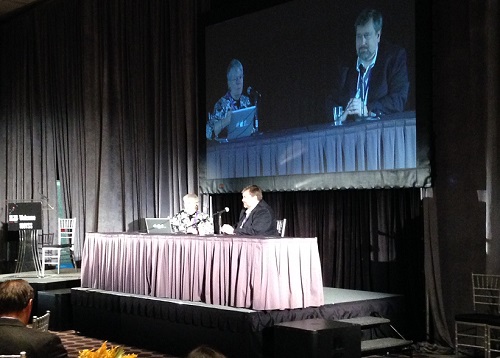
Tarter was interested in what she called a ‘mega-Kickstarter from the world’ as a funding source for another kind of technology, a starshade. In reports for the NASA Institute for Advanced Concepts a few years back (still available at the NIAC site), Webster Cash (University of Colorado at Boulder) outlined the possibilities. Even the largest planets are invariably drowned out by the glare of the parent star, but a starshade approximately 20,000 kilometers away from a large space instrument like the James Webb Space Telescope uses a highly-refined ‘flower-petal’ architecture to filter out the starlight, leaving the telescope with photons from the exoplanet itself. That makes spectroscopy possible, allowing us to study the constituents of a planetary atmosphere.
Starshades are big and have to be deployed, which led Tarter to her next question: Given the kind of miniaturized technology Peck was already working with, couldn’t we make a starshade out of a swarm of smaller objects? The problems are daunting, and include keeping the surface of these structures precise enough to prevent problems with diffraction that can cloud the image. Even so, Peck noted the radical change that computation has brought to optics in the last few years, offering hope of dealing with the optics of widely distributed systems.
And I love this idea: We have places in the Solar System like Enceladus, Europa and Triton, where cryovolcanoes are known to exist. What Tarter calls a ‘shortcut to a sample return’ is to fly a swarm of Sprites through material these cryovolcanoes are throwing into space. Peck’s response:
“I don’t see why not. Small sensors could be distributed throughout this environment. If you fly hundreds — or millions — of Sprites through a geyser, you hedge your bets for survival. Even better, you get spatially and temporally distributed sets of measurements that make a different kind of science possible. It’s a ‘village’ of satellites rather than a single big spacecraft that has to work or you lose the mission. A swarm offers a stochastic or random look at the target.”
The Assumptions of SETI
When the conversation turned to SETI, Tarter talked about current work in the radio and optical part of the spectrum and the need to move to larger apertures and greater computing power, noting that SETI would be part of the Square Kilometer Array that will go online in the 2023-2025 timeframe. In optical wavelengths, the coming generation of instruments like the European Extremely Large Telescope and the Thirty Meter Telescope might have places in the focal plane where SETI detectors could be deployed.
Peck wanted to know whether the assumption was that other civilizations are trying to contact us, or would it be possible to pick up accidental transmissions. Tarter’s response:
“We assume most of the gain is in the transmitter, so receivers don’t need to be as powerful. But in the case of other kinds of signals, those that are not deliberate — think of large astro-engineering programs, for example — any leakage is going to be extremely weak. For these we would have to build the gain into the receivers. But putting huge amounts of money into a single area doesn’t seem the right way to go. Better to do more small but different things. For now, the philosophy is to go for deliberate signals and try to be affordable.”
Driving the push into optical wavelengths has been our own experience. Peck likens the way we currently communicate and return data from spacecraft to ‘exploring the universe with a dial-up modem.’ We have low communications bandwidth and leave about 85 percent of the images we collect on Mars. Improving communications by a factor of ten through laser methods would allow far greater science return. And if we find lasers valuable, wouldn’t other civilizations come to the same conclusion? A large aperture doing individual photon counting can detect a very distant signal.
I liked the note the session ended on, the idea that working on a distant goal like a starship can have wide impact on Earth in the near future. Tarter noted that we’re going to have a large number of megacities before long, teeming with populations of 20 million or more each. Everything we need to learn about maintaining stable life support systems for a starship flows as well into how to keep such cities alive and healthy. Cities as starships. We don’t always plan the solutions that work, but experience has shown how often they emerge from pushing into the unknown.

by Paul Gilster | Feb 14, 2014 | Culture and Society |
Building a starship takes us along an evolutionary path as we master the myriad methods of its creation. And the process does not start at some arbitrary point in the future. Rather, it begins now as we put today’s technologies to work in the service of new concepts. Living ‘meta-technologies’ offer a way into the enclosed but verdant spaces of a worldship. In the essay below, Centauri Dreams regular Rachel Armstrong looks at current projects that explore the kind of biospheres a worldship will entail, and discusses enriched ecosystems that form ‘a new kind of Nature.’ Dr. Armstrong is co-director of AVATAR (Advanced Virtual and Technological Architectural Research) in Architecture & Synthetic Biology at the University of Greenwich, London. She completed clinical training at the John Radcliffe Medical School at Oxford in 1991, and in 2009 began PhD work in chemistry and architecture at University College London.
by Rachel Armstrong

“Why are you crying grandma?”
“I’m not!” The old woman quickly rubbed the back of her hand over a thin gleaming trail on her cheek. “There’s a lot of dust in the air thrown up by those sky hooks! They’re on the move again!”
Several teams of construction workers were using hover diggers to loosen the foundations of what looked like a small hill. They chopped into the humus like a pack of dogs looking for bones, levering sections of earth upwards before finding a new soil horizon to work on. Gradually, they started to expose a porous rock-like framework that was heavily covered with vegetation and subterranean organic matter.
“Where are they taking the Green Hollow now?” asked the child, as troupes of day-glow labourers swung by safety threads from the steel grabber that was making clumsy pinching movements above them.
The afternoon sun was making it difficult to see the details of the architecture, which was rising like a great shadow over the landscape. It no longer appeared green but black, except for where chemically sculptured nurturing light tracks passed through it.
“Up to Persephone, way beyond Earth’s orbit,” replied the old woman. “They’ve been growing the organs for that worldship interior for as long as I can remember. When I was your age, I even remember helping the boiler-suited workers plant the solutions by hand that would form her bones and tissues in the ground beneath us now. They told me that if I looked after them and kept them well fed with scraps of organic matter, then the Green Hollow would grow up big and strong.”
“Like feeding ducks?” asked the child.
The old woman nodded. “Yes, but you have to sow the duck seed to grow the birds first – then feed them!”
…………………………………………
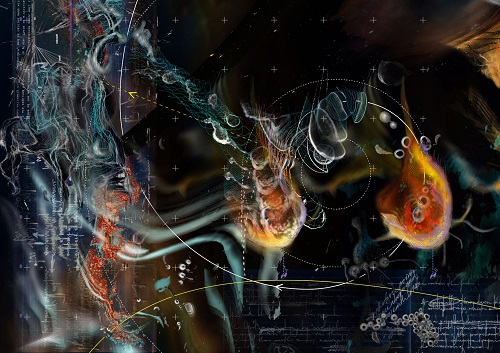
Image: This and other artwork in this essay by Elizabeth Anne Williams.
If we are unable to live ‘sustainably’ on a life-bearing planet – then how do we propose to live amongst the stars, or construct environments so they may become fertile – such as worldships?
At the start of the third millennium we are entering the next stage of human expansion. The scale and speed of our development, with the global spread of industrial processes, is catalyzing a new stage of metabolic evolution for R. Buckminster Fuller’s readymade ‘spaceship earth’ [1]. Yet, the industrial processes that support our growth are collectively ‘reverse terraforming’ our native life support system, such as by releasing stored carbon dioxide from fossil fuels on geological scales [2]. While James Lovelock and Lynn Marguils observed that Earth’s biosphere is a self-regulating system [3], its ability to respond to challenges operates within definable limits and the pressure of human development appears to currently be exceeding the homeostatic capabilities of our planetary system. Specifically, after 150 years of industrialization, our natural systems are being drained to feed our rapidly expanding urban populations with life-sustaining water, fertile soils and minerals [4]. Indeed, owing to the fundamental nature of these infrastructures, space engineering and architecture converge on the shared challenges in designing our life-support systems – which are centred on the issue of ‘sustainability’.
Sustainable development is a relatively new concept that has been emphasized by an awareness of resource constraints in the late 20th century. It invites questions about how current generations can meet their own needs as well as securing the welfare of future generations. Yet, the 1987 Brundtland Report [5] uses general terms to describe the nature of ‘sustainable’ development – as enabling the current generation to meet its own needs without compromising the ability of future generations to provide for themselves. This has precipitated a variety of different approaches to achieve these aims in the practice of the built environment ranging from the biological metaphors of biomimicry, to the decoration of our living spaces with elements from rural vistas in green roofs and walls.
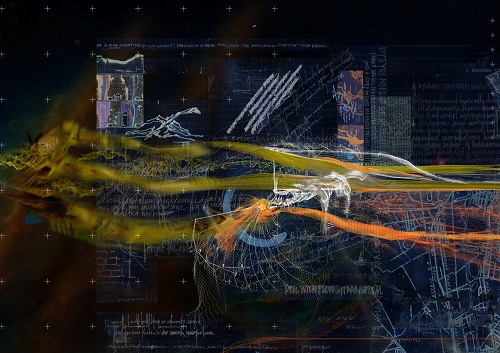
Some methods incorporate the conservation of materials or resources, while others explore a variety of ways to improve the mechanical efficiency of systems. So, when considering a long-term pathway for establishing models of sustainable development, it is worth remembering that the concepts and practices that form ‘sustainable’ narratives are still very much in evolution.
Yet, the prevalent paradigm of sustainability operates according to the principles of resource conservation and operates as a ‘better’ kind of industrialization. In the absence of approaches that directly enrich our ecosystems, we are compromising the ability of generations to provide for themselves. Indeed, only a very few systems have been designed that can support sustained living in resource constrained environments. These ‘biospheres’ are technologically constructed, closed and controlled experiments, which propose to help us manage the Earth’s resources better. Potentially they enable us to establish ecosystems beyond the Earth’s surface and include projects such as BIOS-3 [6] and Biosphere 2 [7]. The price of these constructed environments helps append a monetary value to the services provided by natural ecosystems. For example, the International Space Station, which may be regarded as a biosphere that is regularly topped up with fresh resources, has cost between $100-150 billion [8] and during the Biosphere 2 project $9,000,000 was spent on each crew member per year [9].
Yet, such valuations cannot convey the investment made by Earth’s systems in producing a life-bearing planet. These have been made over billions of years through processes that we do not fully understand. The outcome of these natural systems is a range of priceless technologies that are formed from the integration of natural forces, which transform one set of substances into another through the process of metabolism and include soils, forests and crude oil [10]. Recently, we have been able to manipulate living systems at such small scales and with such precision that we are starting to understand how we may apply living processes as a kind of 21st century technology in ways that reinforce the actions of natural systems. By developing this new toolset potentially, in the longer term, human development may be synonymous with an increase in planetary fertility.
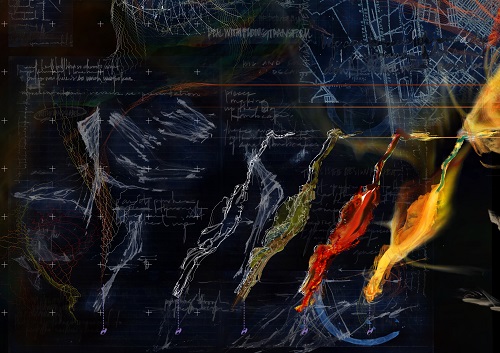
‘Ecopoiesis’ is the science that studies the transformation of inert terrains such as the Martian surface into life-bearing ones [11].To facilitate the production of life-promoting systems, these principles could also be applied to other lifeless terrains, such as metallic starship interiors, or the concrete surfaces of cities.
Indeed, life-enhancing habitats are a fundamental requirement for architectural projects in resource-constrained environments, and many principles can be explored on Earth’s surface without incurring the costs and extra degrees of technological difficulty associated with building non-terrestrial habitats. Indeed, an experimental approach to the design of buildings to increase environmental fertility and promote new ways of thinking about closed ecological systems could be developed by multi-disciplinary teams of researchers where multiple stakeholders – from space agencies, to property owners – may benefit from the construction challenges, ecological discoveries and post-occupancy evaluations in the pursuit of life-promoting architectures. While some novel materials with lifelike properties already exist as commercial products, such as Mycoform [12], which is a building material produced from compacted fungal mycelium, many innovations in bioprocessing are still prototypes. This presents a wealth of new opportunities for the exploration of new concepts in sustainability.
One such project is a collaboration between Astudio architects, Sustainable Now Technologies, AVATAR (Advanced Virtual And Technological Architectural Research) group at the University of Greenwich and the students at the Twickenham Academy in London, which applies an experimental algaeponics technology – the Greenstone Device – in an architectural context. This prototype cutting edge biotechnology system was designed specifically for the Twickenham Academy 6th form as a way of fixing 1 metric ton of carbon every 2.2. years. The facility provides students with access to state of the art, sustainable technology that forms the basis for unique project work that are integral to the 6th form curriculum. Students use the Greenstone Device to strudy the economics of carbon capture to the range of products generated by the technology.
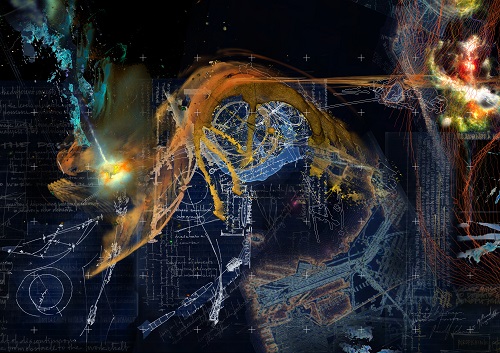
The questions raised by this integrated algaeponics project may be relevant to space programs – in the short and long term – that are investigating the possibilities of aqueous ecosystems in extra-terrestrial environments. For example, the European Space Agency’s MELISSA (Micro-Ecological Life Support Systems Alternative) project, seeks to produce food and reclaim minerals, water and oxygen through bioprocessing systems using waste matter such as, faeces, urea and carbon dioxide [13]. Extending the space research into terrestrial settings through a combined research program could expand our knowledge of constructing closed system ecologies and help develop next generation expertise in a new portfolio of materials, infrastructures, technologies and economic models. These may help us develop life-promoting habitats across a range of environments that span from the Earth to the stars.
Yet the impacts of possible new fusions and collaborations may also produce more immediate impacts on our urban living spaces, since lifelike technologies require similar kinds of infrastructures to fully alive systems. For example, bioprocesses require circulation of nutrient supplies through streams of air and water, which could take place within the walls of our homes [14]. Setting up non-equilibrium conditions within the fabric of our buildings enables them to be more than containers for living processes but to act as bioprocessing sites, which can perform a whole range of useful tasks that can be thought of as extended ‘organs’ to digest waste, recycle water, remove environmental toxins and even provide food for their inhabitants.
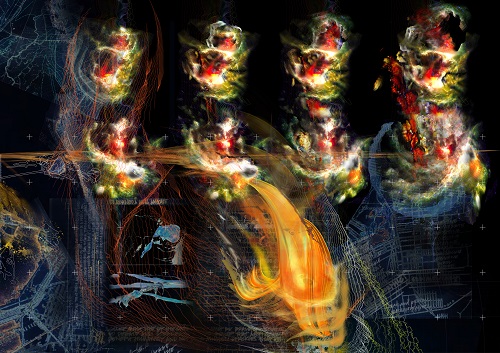
Moreover, lively building fabrics with metabolisms and physiologies do not need to be monstrous edifices. They could constitute a quiet revolution, which is locally produced and shaped by maker communities of bio hackers that are already developing experimental prototypes in their bedrooms, such as Cathal Garvey’s synthetic biology laboratory in Cork [15]. They may simply creep up quietly on our living spaces to infiltrate forgotten and under imagined spaces such as roofs, cavity walls and gaps under floorboards. Nor do they have to exist without aesthetic sensibilities. The Dutch electronics company Phillips proposes that our next generations of biochemical digesters will be so beautiful they will be on display in our homes. For example, bioluminescent bacteria may be housed in vials of beautiful hand-blown glass cells, which use waste that is generated in the average home to produce low-level, mood-elevating light [16].
Indeed, an immediate investment in developing the conceptual and technological infrastructures to produce life-promoting environments may have far reaching benefits in the long term – where buildings are sites for micro agricultures that produce rich, fertile fabrics, such as soils and coral reefs. In turn, these may provide a native infrastructure that possesses the richness and diversity that enrich existing ecosystems and could be considered to exist within a spectrum of natural processes as a new kind of Nature. Indeed, the mutually reinforcing approaches that exist at the intersection between space research and sustainable architecture, may help us better understand how to design, engineer and inhabit closed system ecologies through the design and prototyping of post natural fabrics, which could be prototyped within the everyday context of our swelling cities. For example, the opportunities for material fertility within micro sites may be enhanced by orchestrating the flow and transformation of matter through them in a large range of forms such as, synthetic soils grown from complex chemistries, entanglements of silicon circuitry and cell cultures, or green plants with bead-like metallic micro batteries.
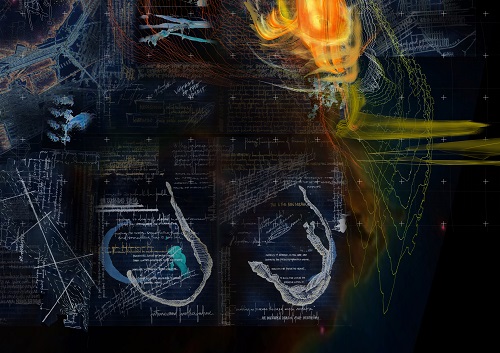
These heterogeneous fabrics may eat with us, breathe, age and feel alongside us. They may process our biochemistry as if they were our own native extended organs and embody aesthetic preferences that convey our desires and betray our emotions because they are woven through our own design. Indeed, the diversity and versatility of their configurations may not only help us increase the liveability of our surroundings and establish fundamental principles for the construction of synthetic ecosystems in every conceivable environment but offer us new survival strategies that support this current wave of human expansion. Yet, we do not have to wait for starships to be realised before we conduct these ecological experiments. Rather we can create a liveable legacy for today’s sustainability challenges by changing our expectations of our cities, habitats and ecosystems to create new, evolvable foundations that weave together the territories between the Earth and stars through living toolsets.
The developments that take us beyond this planet do not need to be conducted within a vacuum. Indeed, it makes economic and scientific sense to prototype new ideas within the resource-challenged sites of our current cities, where our learning can be extended across generations of architects, engineers and scientific researchers. The outcomes of these explorations will inform the construction principles, substrates and technologies necessary for the development of habitable worldship interiors and the principles that will enable us to transform barren environments into ones that can support new kinds of life. Indeed, weaving starship fabrics into our cities will enable us to seed life throughout the cosmos, long before the first colonies ever leave our home planet.

…………………………………………
“It’s scary!” remarked the child, gripping his grandmother’s hand.
“I suppose so.” Mused the old woman, noting how the striking absence of life made the gaping hole where the Green Hollow had once been seem particularly ominous. “But, they’ll start to fill it with duck seed soon!” She smiled reassuringly.
Two skyhooks appeared to walk like giants towards them, rocking in their seven league boots above the horizon. Both grips were clutching tankers of fluid. The day-glow crews moved like spiders on threads between them, guiding and cajoling the monsters until they towered over the cavity in the ground.
An all-terrain-vehicle drove up to the bystanders and an official wearing a peaked olive green cap barked at them to stand back and mind the spray when the tanker contents were discharged into the quarry. He handed them some porous paper face masks, which made everyone look like chickens.
“Planting a new structure was a much simpler operation when I was young!” remarked the grandmother under her paper beak, as the boy wondered what kinds of adventures he might have in a hard peaked hat.
Several long, thin-legged walkers braved the rich spray as the tanker contents were discharged. They deftly folded several layers of a football-pitch sized membrane into the rapidly filling hole that was impregnated with bacterial spores. As the waters rose, the walkers’ legs retracted and became cantilevers that braced their bodies in a flotation formation. They continued to knit and tuck the membranes into the fluid as they also seeded and folded hardy microorganisms in the muddy eddy of the uterine pit. Yet, unlike the lifeless scar left by the quarry, the goo itself was vibrant, feeding and evolving. Even within the first minutes of its existence, strange tubular embryonic forms were starting to yaw, roll and involute like a rising cake mix. By the time the walkers stretched their legs again, the contents of the pit had set like a gel and small birds were nervously landing on its trembling surface, gorging on eluted earthworms.
“Is all the seed in the hole now?” asked the boy.
“I think so,” replied his grandmother as the official swung his arm low, motioning to the public that they could remove their face shields.
“So, what happens now?”
“We wait,” she said.
——-
References
[1] Fuller, R.B. 2008. Operating manual for spaceship earth, Zürich: Lars Muller Publishers.
[2] US National Research Council. 2010. Advancing the science of climate change, America’s climate choices. Washington: National Academies Press. [online] Available at: [Accessed 18 April 2013]. p3.
[3] Lovelock, J. 2000. Gaia: A new look at life on earth, Oxford: Oxford Paperbacks.
[4] Lovelock, J. 2009. The vanishing face of Gaia, New York: Basic Books.
[5] World Commission on Environment and Development.1987. Our common future. Report of the World Commission on environment and development. Published as Annex to General Assembly document A/42/427. Available at: http://www.un-documents.net/our-common- future.pdf. [Accessed 25 April 2013].
[6] Prado, M.E. 1983-2003. Russian CELSS Studies. [online] Available at: http://www.permanent.com/russian-celss.html. [Accessed 22 December 2014].
[7] Avise, J.C. 1994. The real message from Biosphere 2, Conservation Biology, 8(2) pp. 327-329.
[8] European Space Agency. No date. How much does it cost? International Space Station? Human Spaceflight. [online] Available at: http://www.esa.int/Our_Activities/Human_Spaceflight/International_Space_Station/
How_much_does_it_cost. [Accessed 22 December 2013].
[9] Avise, J.C. 1994. The real message from Biosphere 2. Conservation biology, 8(2), p. 327-329. See also Keim, B. 20 April 2009. Biosphere 2 not such a bust. Wired. [online] Available at: http://www.wired.com/wiredscience/2009/04/biospheresci/. Available 26 December 2013].
[10] I am applying the term ‘technology’ to refer to a total cosmic infrastructure of artificial and natural forces that may be harnessed to perform useful work. Heidegger, M. 1978. Being and Time, New Ed. Oxford: Wiley-Blackwell.
[11] Fogg, M.J., “Dynamics of a Terraformed Martian Biosphere,” Journal of the British Interplanetary Society, 46, 293-304 (1993).
[12] Mycoform. No date. Terreform. [online] Available at: http://www.planetaryone.com. [Accessed 27 December 2013].
[13] MELISSA. 8 February 2006. Advanced Life Support, European Space Agency. [online] Available at: http://ecls.esa.int/ecls/?p=melissa. [Accessed 27 December 2013].
[14] This possibility was discussed earlier in a piece on Living Technology.
[15] Regalada, A. 14 February 2012. Doing biotech in my bedroom. MIT Review. Available at: http://www.technologyreview.com/news/426885/doing-biotech-in-my-bedroom/. [Accessed 27 December 2013].
[16] Muppala, S.C. 1 December 2011. Glowing Bioluminescent Bacteria Brings Hope of a New Power-efficient Lighting System. Medindia [online] Available at: http://www.medindia.net/news/Glowing-Bioluminescent-Bacteria-Brings-Hope-of-a-New-Power-efficient-Lighting-System-94186-1.htm#ixzz2etJ33aFN. [Accessed 12 September 2013].

by Paul Gilster | Jan 31, 2014 | Culture and Society |
Librarian and futurist Heath Rezabek has become a familiar figure on Centauri Dreams through his writings on existential risk and how our species might counter it through Vessels, installations conveying our planet’s biological and cultural identity. The Vessel concept is far-reaching, and if we build it on Earth, we would likely take it to the stars. But in what form, and with what purpose? Enter the lightsail starship mission Saudade 4, its crew — some of whom are humans by choice — nourished on the dreams of a continually growing archive. Heath’s chosen medium, the essay form morphing into fiction, conjures the journey star travelers may one day experience.
by Heath Rezabek
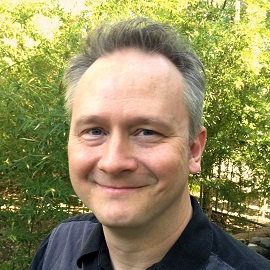
I’ve described The Vessel Project in four prior posts:
August 29, 2013 – Deep Time: The Nature of Existential Risk
October 3, 2013 – Visualizing Vessel
November 7, 2013 – Towards a Vessel Pattern Language
December 13, 2013 – Vessel: A Science Fiction Prototype
As I began preparing my paper on the Vessel project for the 2012 100YSS Symposium, one of the first things to occur to me was the potential crossover between the project’s goals and some of the functional requirements of a starship. While at heart a Vessel installation would be a comprehensive archive, the capacity of such a thing suggested so much more. I’ll explore these other facets through essay and fiction in coming installments.
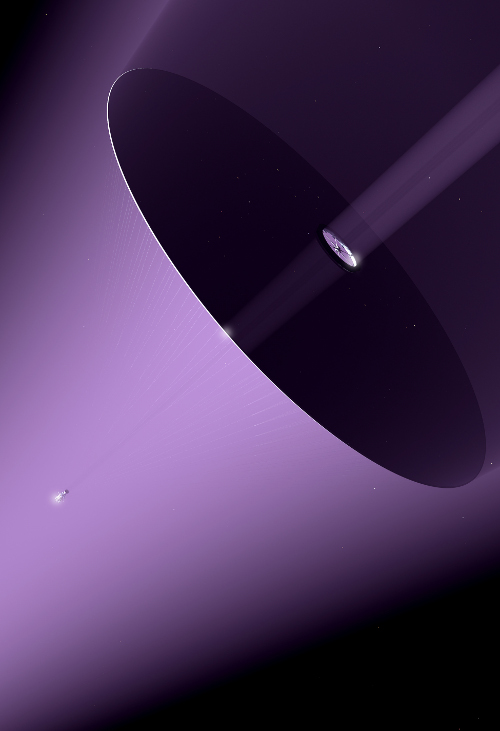
Figure 1: Sailship – Adrian Mann (Used by Permission).
Providing a guiding intelligence for a starship would entail quite a lot. One role facilitated by a comprehensive archive would be that of ambient intelligence, a pervasive sentience throughout the craft. We can envision a starship as a layered technology, with data storage systems as one core element, surrounding habitat systems (however abstracted towards mere life support) as a surrounding space, and computational capabilities infused throughout like a nervous system.
Within this model, duties might include providing for the crew, whatever form that crew may take. We can envision miniaturized crew, artificial crew, biologically engineered crew, hibernating crew: all of these and more (unless completely inchoate or unconscious for the duration, as in a case where the crew is actually a cargo of nascent or embryonic humans) might make use of some kind of virtual environment in which to exercise their minds and their conscious needs.
In his paper “Transition from Niche Decision Support to Pervasive Cybernetics,” also presented at 100YSS 2012, Patrick Talbot detailed a framework for a cybernetic nervous system to be woven throughout a ship, as a self-aware knowledge base. It would need to be capable and flexible to handle the many functions needed of such a craft. The Artificial Intelligence Module (AIM) suggested by Talbot has some interesting qualities, including the design goal of deriving new patterns (“unknown unknowns”) through abstracting structured stories from its knowledge base. [1] Talbot’s model, along with a real-world creative writing exercise I’ve used in workshops, inspired aspects of Avatamsaka, the synthetic mind in this story fragment.
An archive that was comprehensive enough, and that included the means to sample from its contents and yield novel outputs not envisioned by its compilers, could conjure up whole worlds of the imagination for its dependent crew. This would of course yield a vast probability space for exploration, and also for assimilation of the contents of that archive over time.
It also lets us explore the Simulation Argument, [2] while providing one relatively benevolent answer to the question of why such comprehensive universe simulations might ever be run: To provide space and time for a passenger’s mind to roam. Thus, in addition to providing fertile ground on which to play out the unfolding of myriad possibilities in endless combinations, this fictional scenario also provides a counterpoint to cases in which a simulated universe would seem a cruelty. [3]
Here, I explore some of these themes, and touch on more to come.
[1] Talbot, P. “Transition from Niche Decision Support to Pervasive Cybernetics,” 100 Year Starship 2012 Symposium Conference Proceedings, 143-154 (2013).
[2] Bostrom, N. “The Simulation Argument: Are You Living in a Computer Simulation?” (http://www.simulation-argument.com). Accessed January 2014.
[3] Searle, R. “The Ethics of a Simulated Universe” (http://utopiaordystopia.com/2013/03/17/the-ethics-of-a-simulated-universe). Accessed January 2014.
Woven Light: Adamantine

Figure 2: Mountain Shelter – Heath Rezabek
The sun was a golden haze, settling down upon this shambles by the sea. Near, inside a pilgrim’s shelter, Mentor Kaasura nodded at last light as it draped over hills and low roads, long since overgrown.
He had been seated there for much of the afternoon, sheltering from skittish rains. Before him, not far as a man might hike, lay the nameless, ruinous complex. Rusting generators brooded; breached coolant towers numbly gaped at the tumbling forest which scaled Iron Mountain to their west; behind their backs grey waves heaved and raked indifferently at the remains of its foundations.
None had lived here, or anywhere near these sleeping, vacant forms, for several generations; yet not far away, these timber shelters remained, small shadows crouching on the paths which faded into the hills. These leaning structures, maintained as they were by pilgrims of several sorts, each hosted a strange assortment of stowed and forgotten things.
Some of these were maps, through dreamlands now believed to be exposed here. Some were meditative texts, guiding the mindful reader towards countless branching worlds. And some were simply manuals on how to move through wilderness or doubt in a feral world.
But Mentor Kaasura had come in here clear of mind, free from fear, and had found this particular lean-to in the way he still recalled. Slowly stalking up the hillside, as the path around him crumbled into overgrowth and tussock, he had passed from shade to shade while lining up the old wayfinding beacons with ones more distant, until they drew a line upon which the distant Oiinu Arcology seemed to balance like a domed and lidded platter. And then, hardly needing to turn to enter the door, he sat to begin his meditations.
Clear and distant, a voice from before: ~If you go there, you’ll never return.~ His sister’s entreaty had seemed dismissive at the time, but hearing it again, through the lens of all their time before, he could see it had been a simple observation. Seasons returned; people returned. But time could not be rewound. Though things returned, they did so changed. He too would return, but the part of him that made the pilgrimage would recycle itself transformed. And so Kaasura sat.
He was here to ponder cycles. Though years were stretched long now, and little seemed to change from day to day, he knew from his own Mentor that there once had been a time when upheavals had seemed constant. The means to shape the world had unfolded and enfolded those who’d lived through that time, leading on to many things; even, yes, the crumbled generators now sinking into the valley below. He was here to ponder the means by which cycles stretched and snapped short.
But he was also in this place because he knew that here, the veil that braced the delving deeps was worn thin; and that this particular shelter, hugging the ragged mountain wall behind him, was a secret feint, a camouflaged diversion. He knew that he sat before an opening driven deep into the mountainside; he could feel a flow of slow sentience flooding the hut, streaming outwards from far behind him, and he shivered on his stump.
He could hear it just as well: a kind of sighing, or so he imagined. And so with eyes closed, to set imaginings aside, he began the traditional meditation on what still was called mortality; he saw himself standing out upon the road, then turning around to face the hut and him within it, standing firm as he gazed at the shelter, the brooding clouds above, the whispering shoots that crowded on all sides; and he saw himself clearly, seated there, facing out, eyes still shut.
And reaching down, as gently as he could, he took from his imagining hands a small and shimmering shard of knotted light, and bowed.
Stepping then beyond himself to enter this collapsing roof of a room, he faced the rear wall’s faded hanging, woven dense with interlacing. Beyond, he knew, lay the narrow channel through its iron-laden stone, walls dense with carven alcoves, splaying inwards into countless caverns and rivulets and grottos.
Mentor Kaasura paused, watching his outbreath. He committed to memory as much as he could of the tapestry’s patterned weave. Then blinking, his checkpoint saved, he stepped within.
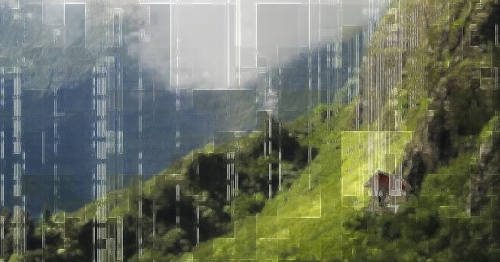
Figure 3: Mountain Shelter (Detail) – Heath Rezabek
– – –
By the mid-21st century, Project Avatamsaka had yielded the most robust synthetic mind ever conceived. To that point, swarm AI had shown some promise, and conscious aggregate drone-clouds had several times surmounted emergency response situations which had left other systems dismayed. Newer and greater challenges had in time sparked the rising of new minds to meet them.
Avatamsaka was different. For this system had to lend spirit to a starship, with all the agency that implied. Design decisions had been made which only in hindsight could be seen as more than the sum of their parts.
Avatamsaka presented itself as a unitary consciousness, though not always as the same one. Depending on the approach of the crew member, Avatamsaka could appear as either female or male, and to varying degrees; its range of personalities would waver when first approached, until settling into a fairly stable persona while dealing with any one person. The logician would confront a transcendent algorithm. The vain would confront an inscrutable foil. And the dreamer would stand face to face with an imagination unending.
This kaleidoscopic impact was not entirely by design: the mind had been built to stay adaptive, and couldn’t have been otherwise, but the scale of adaptation was wholly unplanned and had come from Avatamsaka hirself.
Hir central core was not unique; there were copies and backups in various places, each a singular starting point for sentient aggregation. Like seeds, data cores could be planted within a digital mesh, and would bloom from within. These simple seeds had come from another project altogether, but as Project Avatamsaka had worked itself up to speed, it was seen that the one could easily benefit the other.
Each cubic lattice was called a Vessel cache, and their sizes varied greatly. Though they appeared quite the opposite, at simplest any one of these cores could be modeled as a black box. The outside world went in, and was drawn back out in fragments, glimpses, sketches, connections found between the elements emerging and new wholes reassembled on the fly.
In this way, it turned out to make an excellent foil for the pattern-finding at which Avatamsaka excelled.
The basic process of concept discovery and reconstruction was called pattern-sampling (or patterning), and could be experienced (in principle) as a kind of a game. Thus:
– Take your nearly-infinite deck of cards, with nearly-infinite things on them. This is your Vessel.
– Draw any number of samples. (Let’s say 5.)
– Identify just over half of them as most readily related or relatable. (Let’s say 3.)
– Discard the outliers. The remaining set is your glimpse of knowledge, your pattern-sample. Do with it what you will.

Figure 4: Pattern Sample – (public domain elements)
– – –
The ultimate aim was for Avatamsaka to use these sets to perform all the tasks and functions of a living lightsail starship. For a starship on an extended voyage, the tasks are many, and most of them are mission-critical as the time window for potential failure is so wide. But among these tasks, one of the less critical yet more complex was the augmentation of reflexive dreamworlds for the crew to experience during the voyage. “Crew” was an interesting term by the time the four ships called Saudade set sail. Certainly, what amounted to petri dishes outnumbered the astronauts. A minority of the crew was what we would have called human, and most of those people were people by choice.
——-
The Avaai had chosen to remain in human form, albeit an optimized one. If there had been a reason, these crew in theory could have navigated the actual physical spaceframe of Saudade IV. But there were also a slim few, who had chosen to be set into stasis entirely, as their bodies were barely augmented at all. These were the Ghemaai, and their choice would have been a tremendous burden had they not been an archival decision in the first place.
As things stood, they were no more a burden in their hibernating forms than the tanks of lastline biomass sampled from Earth’s biomes. And like their wild kin, even in their stasis, the Ghemaai could dream.
Or delve, as the term was. This state was unlike what we’d have recognized as dreaming, as much of the source material for these inner lives was drawn from the nearly-infinite stores of the Vessel cache by Avatamsaka, vented in pattern-samples to the nervous systems of all who slept, whether Avaai or Ghemaai.
When the nearly-infinite range of pattern-sampled impressions contained within a Vessel cache was blended with the nearly-infinite intuitive capacities of a sentient being, novel things happened. For the purposes of the crew of the Saudade IV, the most novel of these was the simple fact that through these means, generations of lives could be lived out in seeming, in complete immersion, flowing starwards through space.
One of the family lines enmeshed in this way bore the last name of Ramer. But only one of the lightsails in the first fleet bore those folk as crew or cargo, and as you may have guessed by now, this was Saudade IV. We can guess that there were at least four such craft in that fleet; but we can’t know if there were more, or where this leaves the other three.
~We can’t even know if there truly were three others to start with~ mused Odiah Ramer, when first he thought it through. But he was delving deep in the weave of the Avaai at the time, and before the lesson arcs had been patterned to guide fretful minds, this place was a disorienting place to be.
– – –
Somewhere in spacetime, Avatamsaka glides through the depth between stars, clad only in a lightsail named Saudade.

Figure 5: Sailship (Detail.) – Adrian Mann. (Used by Permission.)

by Paul Gilster | Oct 28, 2013 | Culture and Society |
Oxford-based Stephen Ashworth, who attended the recent Starship Century event in London, obviously took copious notes, as reflected in the piece that follows. Ashworth is a Centauri Dreams regular, a writer and musician who, like so many of us on this site, ponders the big questions of our engagement with — and exploration of — the universe. Here he reflects on the immense challenge of starflight and lets us know how a number of key players now see it. For more of Stephen’s perceptive work, check in regularly at his Astronautical Evolution site.
by Stephen Ashworth
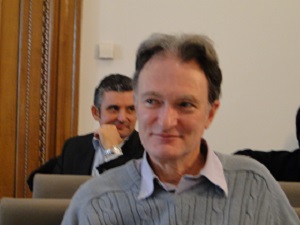
The new book Starship Century, edited by physicists James and Gregory Benford and with contributions from many active in the interstellar field, takes a broad view of questions of interstellar exploration, the editors told this meeting at the Royal Astronomical Society in London on 21 October 2013. In the first place, why has there been such a surge of interest over the past decade or so, with several new organisations devoted to interstellar travel appearing on the scene? Is the 21st the century humanity will build starships, and if so, why and how?
With Voyager 1 now having crossed the heliopause and New Horizons due to make its flyby of Pluto in less than two years time, finishing the initial reconnaissance of the Solar System, together with a flood of exoplanet discoveries, including the first indications of a planet in the Alpha Centauri system, the time appears right for interstellar exploration to inspire growing interest, James Benford said in his introductory talk.
Yet the task is immense. Before our ancestors learned to ride horses, they were only able to move at a walking speed, on the order of a metre per second. The Apollo astronauts departed from and returned to Earth at speeds around 104 times faster. A cruising speed of a significant fraction of the speed of light, necessary to reach the stars in a reasonable period of time, would require another 104 times jump.
Moreover, in order to make that jump one is running up against the limits of known energy sources. An object flying at 3.75% of light speed possesses the same kinetic energy per kilogram of mass as that released in a thermonuclear explosion.
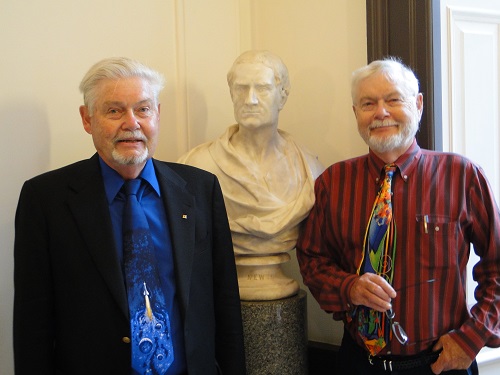
Image: James (left) and Gregory Benford at the Starship Century symposium, along with a bust of Sir Isaac Newton.
In an article in Physics Today back in 1968, Freeman Dyson predicted that the first interstellar voyages would be possible in 200 years time. However, he recently reiterated that they would still be possible in 200 years time – the familiar tale of an ever-receding goal. Harnessing the immense energies of nuclear fusion reactions, whether for commercial power generation or for rocket propulsion, is not turning out to be easy.
What about the attitude of the public? Benford displayed a cartoon: an ascending sequence of technological achievements in chronological order – a horse-drawn wagon, a car, a locomotive, an aircraft, a space rocket – as rough drawings on a wall. Then you notice that the artist is a caveman. Then zoom out, and you see a cavewoman watching him skeptically, and asking him when he’s going to get the meat in for their dinner. The triumphalist belief in inevitable progress is a nerdish pursuit, and the majority of the public can see no further than the desire to solve their day to day problems.
(However, in The Demon-Haunted World Carl Sagan wrote of the critical importance of those denigrated as “nerds” in making progress possible – his example was James Clerk Maxwell. – Comments in parentheses such as this are my personal reflections after the event.)
For the present, interstellar progress is in the hands of six private groups, all with very small budgets: the British Interplanetary Society (the oldest, founded in 1933), the Tau Zero Foundation, Icarus Interstellar, the 100 Year Starship Organization, the Institute for Interstellar Studies, and most recently the New Horizons Message Initiative. (Given its website and organisation of meetings such as this one, surely Starship Century itself counts as the seventh group?)
Cascading opportunities among a galaxy of planets
James Benford’s brother Gregory presented a quotation about the prospect for development of North America from Thomas Jefferson back in 1812: “It will take a thousand years for the frontier to reach the Pacific.” Jefferson was assuming that colonists would be limited to the capabilities of horse-drawn wagons, yet the steam engine was already a reality, and communications across the continent were vastly accelerated when the trans-continental railroad was completed in 1869.
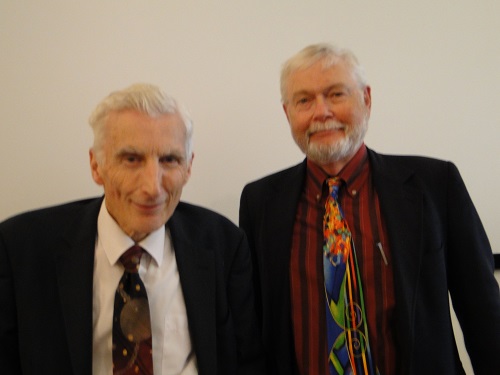
Image: Lord Martin Rees and Gregory Benford.
So Jefferson’s estimate was out by more than an order of magnitude. It didn’t occur to him that opportunities in technology and the economy would cascade to drive settlement of the interior. In a similar way, during the coming century we could be seeing a combination of nuclear rockets, robotics and 3D printing working together to accelerate the economic opening up of the Solar System, which will be essential to exploring beyond it.
Ian Crawford, professor of astronomy at Birkbeck College, London, displayed a plot of exoplanet discoveries made by the Kepler mission (see below), the conclusion of which had to be that virtually all main-sequence stars do in fact have planets of one sort or another. But because it is easier to find them by the transit method, only four are currently known (with varying levels of reliability) within 15 light-years of the Sun, orbiting Alpha Centauri B, Tau Ceti, Epsilon Eridani, and the red dwarf GJ 674.
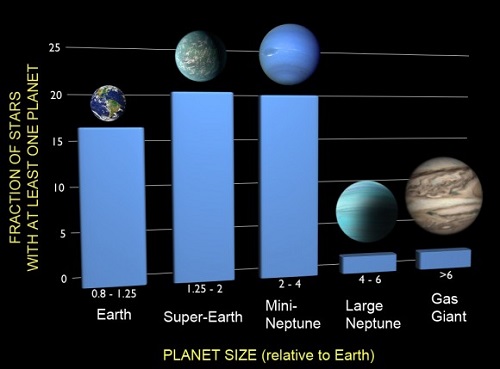
Image: A new analysis examined the frequencies of planets of different sizes based on findings from NASA’s Kepler spacecraft, correcting for both incompleteness and false positives. The results show that one in six stars has an Earth-sized planet in a tight orbit. Credit: F. Fressin (CfA)
More nearby planets will surely be discovered as techniques improve, with the James Webb Space Telescope, the Transiting Exoplanet Survey Satellite (TESS, the planned successor to Kepler) and Europe’s Exoplanet Characterisation Observatory (EChO) in prospect, as well as continuing improvements in adaptive optics applied to large ground-based telescopes.
The ideal tool would be something like Europe’s Darwin space interferometer, which would be capable of obtaining the spectra of Earthlike exoplanets. But Darwin is not currently under development. And, as Charles Cockell has pointed out, even if the spectra of gases associated on Earth with life (H2O, CO2, O3) are obtained, they would not definitively prove that life had to be present, nor would they tell us anything about the nature of that life if it existed. The spectrum of Earth must have appeared much the same over the past two billion years, through dramatically different epochs of its biological history.
The only way to be sure would be to send an interstellar probe that could make in-situ measurements. Crawford presented his shopping list for the instruments he would like to carry on that probe, with a whole array of orbiters, landers and atmospheric entry probes, arriving at a mass decelerated into the target system in the range of 150 to 200 tonnes.
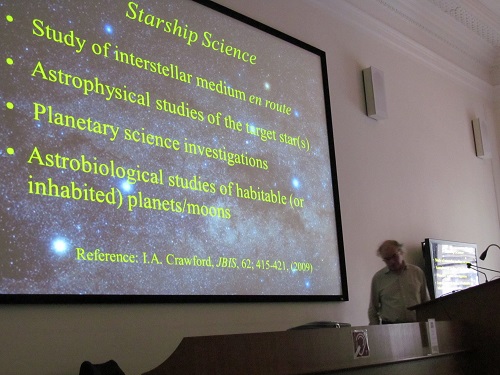
Image: Ian Crawford discussing instrumentation for an interstellar probe.
But his reasons for interstellar exploration extend beyond science. He presented arguments from the seventeenth-century philosopher John Locke, who reasoned that the human imagination cannot produce anything genuinely new. In order to refresh both science and our broader culture, therefore, it is necessary to go out and physically discover genuinely new things. Interstellar exploration more than any other pursuit puts us on track to discover things that have never been thought of before.
Stephen Baxter, the well-known science fiction author and, like Crawford, an Icarus team member, discussed what might happen if one of our interstellar probes were to encounter intelligence at its destination. On the assumption that we had not known of the existence of intelligent life there when the probe was despatched, contact would take place when the vehicle was remote from any direct human control. How would it detect and recognise alien intelligence, and how might it be programmed to respond?

Image: Stephen Baxter on probes and the potential for contact.
Of course, the extraterrestrials might see our vehicle arriving, and Baxter discussed ways in which this might come about. (Implausible, I thought: if they were that technically advanced, they would surely have visited us long before. The time window in which they are developed enough to detect, say, the exhaust from the fusion engine of a decelerating vehicle, and to recognise it for what it is, but not developed enough to be launching their own interstellar vehicles, would be only a few centuries at most in the history of a species whose origin is not coordinated with that of H. sapiens and might well be millions to billions of years earlier or later.)
These issues are presented in more detail in Baxter’s article in the Jan./Feb. 2013 issue of JBIS. He also noted that his own latest novel, Proxima, is, appropriately enough, an interstellar yarn.
The word from the A.R.
(I don’t know if people still call the Astronomer Royal “A.R.”, but I did re-read Fred Hoyle’s classic The Black Cloud not so long ago, and they certainly did then.)
Lord Martin Rees, the Astronomer Royal, has written extensively on the cosmos and the outlook for human civilisation. He brought an astronomer’s perspective on time to the Symposium, particularly future time: assuming we do not become extinct, post-human evolution will be much longer than that which led up to us, and will moreover be accelerated and directed in new ways by genetic and computer technologies. So far as our evolution is concerned, we have not yet reached even the halfway point.
What role, he asked, will humans play in space? In contrast with Ian Crawford’s well-known view, he did not see any case for astronauts as scientific explorers in an age of increasingly capable robots. But the human adventure of space travel in person was undeniable. He gave two pointers to the human future in space: China might leapfrog the US and send astronauts to Mars, and meanwhile the private sector was also on the verge of sending passengers into space. NASA had become risk-averse, creating an opportunity for privately funded adventurers who were willing to accept greater levels of risk – not as “space tourists”, for that phrase gives a misleading impression of safety and regularity, but as participants in a dangerous sport akin to deep ocean diving or making the ascent of Everest.
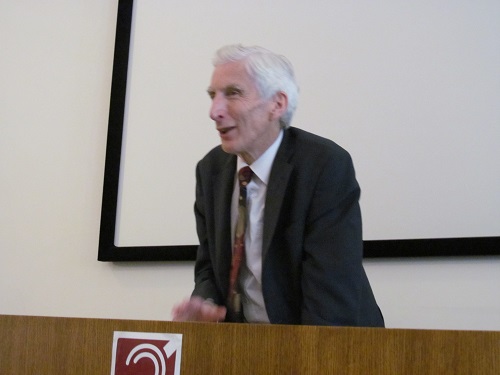
Image: The Astronomer Royal analyzes current space efforts.
(I would disagree with the A.R. on two points here. Having already experienced the disappointment of seeing Soviet cosmonauts fail to reach the Moon, I do not share the enthusiasm for Chinese manned spaceflight. They are currently about where the two traditional superpowers were before the Salyut 6 breakthrough in the late 1970s. I have heard no reason why a Chinese Apollo, Shuttle or continuously occupied Station programme, were such to appear, would be any more sustainable than their American and Russian originals, and they are nowhere near even beginning the major structural reorganisation currently underway across the Atlantic, essential for meaningful progress at this point. Meanwhile, although we do not yet have space tourism as such, the creation of a mass market for space travel at a level of at least 5,000 passengers/year worldwide (say, one planeload of 20 every weekday of the year) at near-airline standards of service seems to me to be vital for consolidating our hold on low Earth orbit, bringing the costs down and reliability up to levels that allow for sustained exploration beyond near-Earth space.)
Lord Rees stated, reasonably enough, that there would never be mass emigration from Earth, and so Earth’s problems would have to be solved on their own terms. But by the end of the current century there could well be small groups of pioneers living away from the mother planet. Interstellar travel, however, is for post-humans, whether genetically modified but still biological humans, or entirely manufactured beings.
He pointed out that explorers of our own planet were in some ways going into the unknown to a far greater extent than astronauts ever will. They were crossing oceans and continents about which nothing was known but much was imagined, completely out of touch with their port of origin, unlike any astronaut, whose journey takes them to lands already surveyed by telescope and probed by robot precursors, and in direct line of sight radio communication (if delayed by light travel time) with Earth. But what terrestrial explorers did have was a high expectation of profitable discoveries leading them ever onward.
As an astronomer, Lord Rees was naturally no stranger to the longest possible future perspectives, when the apparently accelerating cosmological expansion has carried almost all the universe beyond our horizon, leaving only the matter in the Local Group of galaxies accessible to our remote descendants. Maybe they would find that they were living in only one universe in a multiverse, or in someone else’s simulated universe.
General discussion
The presentations were followed by general discussion. There was some debate about the key factors in our intelligence, and in that of any intelligent alien species which we might meet elsewhere in the Galaxy. Biologist and science fiction author Paul McAuley pointed out that species other than ourselves use and make tools, and suggested that the key to our success had been our ability to archive knowledge for future generations to use.
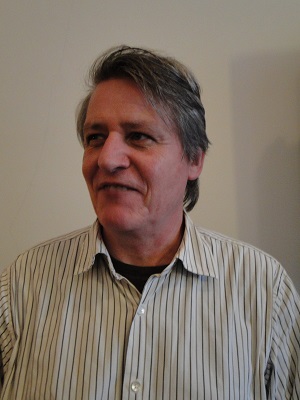
(My own view is that an archive, such as a library containing books, is itself a kind of tool, so that does not answer the question. My answer would be that we are unique in that we not only use and make tools, but that critically we use tools to make better tools. It is this recursive use of technology back onto itself in order to make better technology that is what drives progress.)
I should like to draw particular attention to what was said about the near-term future, before an interstellar mission is even launched. For it is what happens on Earth and in space over the next few years which will determine whether or not our civilisation even has an interstellar future.
Image: Science fiction writer Paul McAuley.
Ian Crawford made the point that the single most important factor was to reduce the cost of access from Earth’s surface to orbit, whether this was done with single-stage-to-orbit spaceplanes, or by construction of a space elevator. (Here let me link to the latest news on Britain’s Skylon spaceplane programme, managed by interstellar pioneer Alan Bond of Daedalus and worldships fame.)
James Benford argued for nuclear rockets, firstly fission engines of the type developed by NASA in the late 1960s, later fusion engines, which would open up the Solar System. SpaceX, he agreed, would surely succeed in lowering costs, but in his view there was also a case for beamed power for access to space. His brother cautioned that the laser-ignition fusion work in which he had been involved forty years previously had still not achieved a useful result, but that there were good prospects for fusion based on the proton-boron reaction. Stephen Baxter proposed that large-scale geoengineering projects, such as building a solar parasol to keep Earth cool, or the large-scale development of solar power satellites, might be an important driver of progress.
The debate over whether space agencies or the private sector are in the better position to lead produced a number of points. Governments are broke, James Benford said, hence the private sector must lead. Governments are risk-averse, Lord Rees added, leading to the same conclusion – new moves will be spearheaded by crazy billionaires, leading small groups of eccentric but highly motivated people. In his view, this would be no bad thing: we should encourage everyone to explore the limits of what humans can do.
But Gregory Benford (whose novel The Martian Race features the Chinese government competing, with European collaboration, in a race to Mars) allowed a possible leading role for government in the case of China.
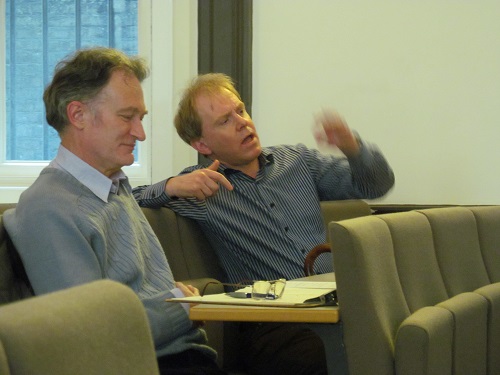
Image: The discussion continues. Stephen Ashworth (left) and Martyn Fogg.
Ian Crawford cautioned that space could not be allowed to become a free-for-all because of the dangers involved when, for example, asteroidal material impacts Earth. One could imagine a private group holding Earth to ransom in this way. It would therefore be necessary for us to evolve appropriate political institutions to ensure that space development is beneficial for all.
James Benford picked up this theme, stating that what governments can do is to make developments possible, or impossible. In the case of railways and canals they set up rights of way, for example by the purchase of land for the trans-continental railroad across the United States. Clearly, governments are also the guarantors of private property, and of the whole system of law and order on which economic prosperity depends. A creative synergy between government and private enterprise is therefore surely the way forward.
Next step: read the book!
In summary, then, this was a stimulating meeting with several of the key thinkers in the interstellar field. It was an excellent opportunity for people in Britain like myself who cannot hop across the Atlantic to attend interstellar conferences in the US, and it deserved to have been more fully attended (as it was, there were seats to spare in the smallish auditorium where the meeting took place).
The breadth and confidence of the vision of humanity’s and post-humanity’s interstellar future, presented in this and many other conferences, contrasts oddly with the current confusion and controversy about the direction of the public space programme in the United States, and with the apathy and stagnation in Europe. Clearly a major reorganisation of the space industry is under way, leading towards a more economically based industry in which government is one customer among many, as is already the case for Earth satellites but not yet the case for manned spaceflight, or for robotic ventures beyond geostationary orbit.
More details and discussion, from the speakers at this meeting and many others, may be found in the Starship Century book.
My thanks to the Benfords and to our hosts at the Royal Astronomical Society for organising this event.

by Paul Gilster | Sep 27, 2013 | Culture and Society |
The timing of the announcement that Voyager 1 has, for some time now, been an interstellar spacecraft came just before the 100 Year Starship Symposium and was certainly in everyone’s thoughts during the event. Jeffrey Nosanov (Jet Propulsion Laboratory) reminded a Saturday morning session led by Jill Tarter that when the Voyager program was conceived, the notion of going interstellar was the furthest thing from the planners’ minds. Voyager’s adventures beyond the heliopause are what Nosanov now calls ‘almost a completely accidental mission.’
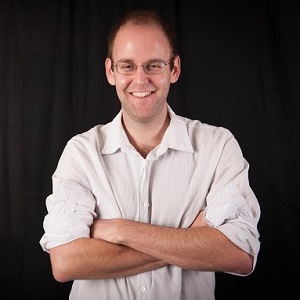
How to follow up the Voyager success? For one thing, we already have New Horizons on its way to Pluto/Charon, with flyby in 2015, and I’ve already discussed the New Horizons Message Initiative, which would upload the sights and perhaps sounds of Earth to a small portion of the spacecraft’s memory after its encounters are done (see New Horizons: Surprise in Houston for more). But Nosanov asked Voyager project scientist Ed Stone, himself all but legendary in his association with the spacecraft, what he would like to see happen next. Stone said he’d like to see ten or a dozen spacecraft sent out in different directions to the same distance.
Image: JPL’s Jeffrey Nosanov, whose work now includes a study of next-step missions beyond Voyager.
Nosanov’s recently accepted proposal to NASA’s Innovative Advanced Concepts (NIAC) Program will examine just that scenario. What he plans to do is to design a spacecraft architecture that will probe what the project description calls ‘ the unique regions of the Heliopause, known as the nose, sides, tail, north and south.’ Flybys of the outer planets and Kuiper Belt objects as well as studies of the heliopause itself are what Nosanov has in mind, but he goes still further, looking toward reaching the Sun’s gravitational lens at 550 AU and beyond to study imaging of the center of the galaxy and other targets at various wavelengths.
State of the Universe
Speaking of working at various wavelengths, the morning “State of the Universe” session began with project scientist Adrian Tiplady discussing South Africa’s role in the Square Kilometer Array, itself a multi-national collaborative project whose 3000 small dishes will carry ten to one hundred times the traffic of the global Internet at any one time. The MeerKAT installation is a precursor for the full array, one whose 64 dishes will make it the largest radio telescope in the southern hemisphere until the Square Kilometer Array is completed some time in 2024. Extending across a number of African nations and into Australia, SKA will be fifty times more sensitive than any other radio instrument, a huge challenge in engineering as well as collaboration.
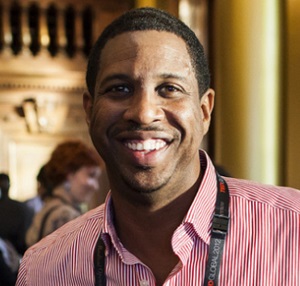
The State of the Universe panel was a lively session, held in the Hyatt’s ballroom and sparked by an enthusiastic Hakeem Oluseyi (Florida Institute of Technology), who offered an overview on our attempt to find dark matter and a whirlwind tour of the early universe following the Big Bang. Oluseyi sees the universe as a place that selects for life-forms that populate the cosmos because planetary existence is sharply limited by extinction events and resource depletion. “Intelligence is needed to move into space,” he added, “but the window of opportunity is finite. Single cell life-forms survive out of robustness, but complex beings need to exploit resources to move into space. Every life form on every planet is in a space race.”
Image: Florida Institute of Technology’s Hakeem Oluseyi, whose rapid-fire tour of the early universe challenged the skills of even this very fast typist attempting to take notes.
I’m skipping a lot of good material to compress this, but I do want to mention that the discussion of exoplanets by David Black (Lunar and Planetary Institute) and Ariel Anbar (Arizona State) brought the crowd up to speed on Kepler — now without fully functioning gyros but sporting a huge list of exoplanet candidates — and methods for studying biosignatures in the atmospheres of distant worlds. Jeff Kuhn’s discussion of the Colossus telescope was a fitting cap to the panel. Kuhn (Institute for Astronomy Maui) described an Earth-based instrument that could perform a census of nearby planets looking for unusual thermodynamic signals. Explaining earlier searches for Dyson spheres, Kuhn went on to discuss how civilizations use power, noting that we use half of one-tenth of one percent of the total energy our planet absorbs from the Sun. Power consumption increases, of course, as civilizations become more advanced.
The inevitable result: The thermal signals Colossus is being designed to look for. The Colossus Consortium, a private organization funded by a wealthy individual, is looking for warm exoplanets that display the heat signature of a functioning civilization. Kuhn’s slide showing Paris in the infrared, a nighttime shot taken by a satellite, drove home the point that the thermal signal we produce is significant, measurable and much larger than what we produce in light. The intention of the Colossus builders is to examine stars within 60 light years for such markers, which would be usefully free of our sociological speculations about what such a civilization might do.
Breakthrough Telescope Technologies
It’s a fascinating concept, and to see more about it, read SETI’s Colossus in these pages, or visit the Colossus site. What I like about it is that it makes no assumptions about why or how an extraterrestrial society might choose to communicate, but depends solely upon its activities on its own world. Joe Ritter, a colleague of Kuhn on Maui, went on to lead a track called “Destinations: Hidden Objects” later that day that delved into the difficulties in exoplanet detection and viewing. Ritter ran through Kepler’s woes and discussed Hubble, the James Webb Space Telescope, and the lamented Space Interferometry Mission that may live on in missions like Darwin.
And with a gorgeous slide of the famous “Pillars of Creation” region in the Eagle Nebula, he also made the point that instrument effects limit our ability to see. Check the image below to confirm Ritter’s point: The bright star at center left does not actually have a cross-like shape, reminding us that diffraction spikes can swamp signals of faint objects in even the best of telescopes. Off-axis telescope designs, which he illustrated, can help in reducing diffraction — the Solar-C experimental coronagraphic telescope on Haleakala is an example of how this can be done.
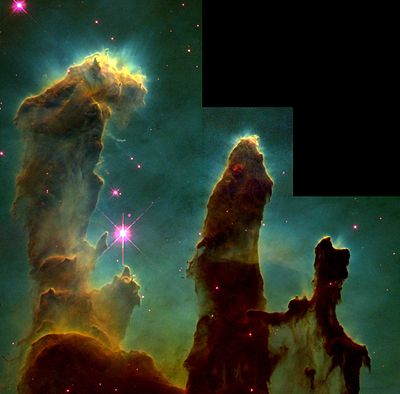
Ritter went on to discuss the uses of polarization, describing forms of spectroscopy that can use polarization to scale away randomly polarized light and leave a more workable signal. With such methods we can hope to separate the light from an exoplanet from the light of its star. The PLANETS telescope (Polarized Light from Atmospheres of Nearby Extraterrestrial Systems) has as its goal to define the atmospheric composition of exoplanets. This one is a 2-meter off-axis telescope now under development at the Institute for Astronomy of the University of Hawaii.
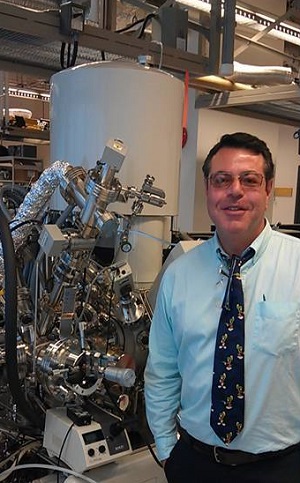
Joe Ritter is a great conversationalist and we enjoyed kicking these and other ideas around after hours at the hotel bar. He’s fascinated with producing thinner apertures and how thin membranes as mirrors can be manipulated by tiny actuators to retain their shape. Polarized light at particular wavelengths can be used on the right materials to create adaptive optics in which the mirror doesn’t actually have to be touched to be re-shaped. Imagine a Hubble-sized mirror (2.4 meters) weighing in at no more than one pound, or a JWST aperture weighing twelve pounds. If we can make such giant apertures, we can use them not only for telescopes but for communications or, dare I say it, as solar sails. This work is so revolutionary in its potential that I’ve asked Joe to write an article about it for Centauri Dreams to explain it in more detail. “Brute force isn’t an elegant way to produce the mirrors we need,” Joe told me. And from what I can see, the work in his lab is both elegant and paradigm-shifting.
Image: Joe Ritter, a name you’ll be seeing much more of on Centauri Dreams in relation to his work on extremely light and thin telescope apertures.
Uses of Science Fiction
Saturday was the symposium’s last full day, so it was perhaps understandable that sessions ran over in the attempt to cram everything in. All of this led to one of the most entertaining episodes of the event, Marc Millis’ talk “From Sci-Fi to Scientific Method: A Case Study with Space Drives.” Marc frequently draws on his work as head of NASA’s Breakthrough Propulsion Physics Project, but this talk is light on equations and long on imagery from science fiction films and how scenarios from such films can inspire creative thought.
An example: We constantly see spaceships in movies where the crew is walking around under what seems to be normal Earth gravity, and as far as we can tell, there is no problem with inertia even when the craft suddenly accelerates. Now if you could actually do that, Millis asks, why wouldn’t your plots take advantage of the fact? An intruder on board wouldn’t need to be handled by security forces. Instead, why not just manipulate the gravity in his location to bounce him off the walls, rendering him unconscious? And drawing on films ranging across the gamut of recent science fiction, Millis extracted scenarios and the questions they raised.
The more serious point is that even a bad science fiction movie can become a spur for thought that encourages new angles into old problems. The key is to promote creativity. Marc had to be amazingly creative himself during his presentation. When I arrived, the late-running panels in the ballroom meant that most people were still there. When Marc was almost at the end of his talk, the room suddenly filled with people, taking up the chairs and sitting on the floor. Without losing a beat, Millis simply went back to the beginning and presented the entire talk a second time. I do a lot of public speaking but I have to say this was something of a tour de force.
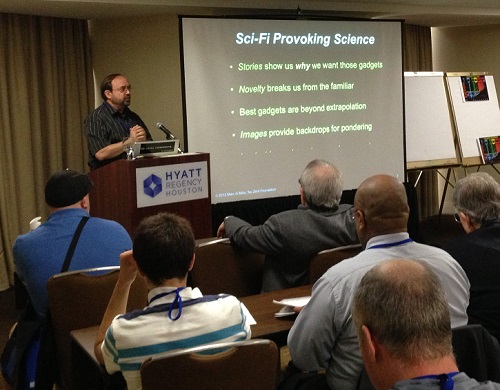
Image: Marc Millis amidst an impromptu reprise of his talk.
I wish I had been able to report on all the talks I attended in these pages but I didn’t have time to run through each. What a year this has been in terms of interstellar conferences. And we still have one to go, a Starship Century event to be held Monday October 21 at the Royal Astronomical Society on Piccadilly in London, with Royal Astronomer Martin Rees as a featured speaker. As I get more information about speakers at this one, I’ll pass it along, and will plan on covering the sessions via live streaming as my travel budget won’t sustain another conference this year.
It used to be that people interested in interstellar flight met in off-schedule gatherings at meetings on other subjects. The explosion of conferences this year is probably unsustainable, but it will be interesting to see what kind of schedule eventually emerges. In any case, it has been a year to remember, one that has put an exclamation point on deep space dreams capped by Voyager, our first interstellar traveler.
































